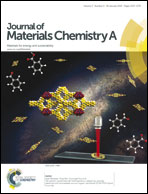Vulcanization accelerator enabled sulfurized carbon materials for high capacity and high stability of lithium–sulfur batteries†
Abstract
Sulfurized carbon is a promising candidate for cathode materials in practical lithium–sulfur batteries due to its high and stable capacity retention, extremely low self-discharge, and excellent safety. The main disadvantage is the relatively low sulfur content in sulfurized carbon materials. Borrowing the idea from rubber crosslinking chemistry, here we report the use of a vulcanization accelerator in carbon sulfurization. Vulcanization accelerators significantly improve sulfur content by ∼8 wt%, which results in a remarkable increase in the discharge capacity of corresponding Li–S batteries by ∼120 mA h g−1 while maintaining the outstanding cycling stability and low self-discharge. The effectiveness of this approach and the wide variety of vulcanization accelerator chemistry will pave the way for sulfurized carbon materials towards practical applications in Li–S batteries.

- This article is part of the themed collection: 2015 Journal of Materials Chemistry A Hot Papers

 Please wait while we load your content...
Please wait while we load your content...